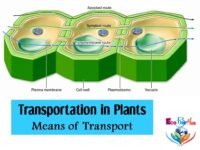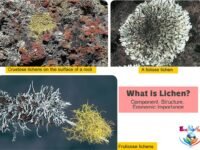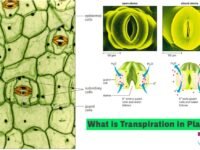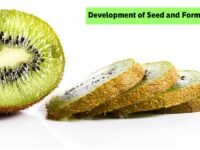In this tutorial, we have discussed ‘what is Mycorrhizae’, ‘ types of mycorrhizae’, ” importance of mycorrhizae’, etc.
TABLE OF CONTENTS
What is Mycorrhizae
— Mycorrhizae (from Greek words meaning “fungus roots”) are the obligate symbiotic relationships with fungi and the root of higher plants. Mycorrhizae occur in about 80% of plants (and more than 90% of all plant families).
—They are thick, irregular without root hair and root сар.
— In a mycorrhizal association, the fungus may colonize the roots of a host plant either intracellularly or extracellularly.
— The fungi in mycorrhizal associations act as extensions of the plant root system. The fungal hyphae dramatically increase the surface area of the plant root that is in contact with the soil, resulting in much more efficient absorption of nutrients such as nitrogen, phosphorus, and trace elements. The plant, on the other hand, supplies organic nutrients (sugars) to the fungus, so the symbiosis is mutualistic.
— To establish and maintain a symbiotic relationship, cells of the fungi and cells of the plant roots must communicate. For example, signaling molecules from the plant root cells stimulate fungal cells to shift to a presymbiotic growth phase in which their energy metabolism increases and their hyphae branch. The fungal cells then signal the root cells, activating a signaling pathway that activates gene expression in the root cells.
Scientists have studied three of the genes, called sym (for symbiosis) genes, that encode the plant’s side of the molecular “handshake” with mycorrhizal fungi. In a recent paper, researchers reported that sym genes are found in all major lineages of land plants. These results imply that the genes were present in the common ancestor of land plants. Furthermore, a phylogeny based on analysis of the three genes proved to be virtually identical to the widely accepted phylogeny [Ref
— It has been observed that the roots with mycorrhizae have better mineral absorption capabilities compared to plant roots.
— Scientists also observed that mycorrhizal plants are often more resistant to diseases, usually caused by microbial soil-borne pathogens; simultaneously, they have more resistance to the effects of drought, perhaps due to the improved water uptake capability of the mycorrhizal hyphae.
► Read More: What is Lichen? Component, Structure, Economic Importance ► Read More: Why Seed Dispersal is important? Agents of Seed Dispersal ► Read More: What is Pollination? Definition, Types, Agents, Significance ► Read More: Reproduction in Plants : Sexual and Asexual reproduction ► Read More: Stem Anatomy || Monocot and Dicot Stem Cross Section || ► Read More: Inflorescence Types || Racemose, Cymose, Mixed, Specialized
Types of Mycorrhizae
— There are two types of mycorrhizae: arbuscular mycorrhizae and ectomycorrhizae. They have distinctive morphologies as well as distinctive functions and geographic distributions.
— Arbuscular mycorrhizae have hyphae that penetrate the outer cells of the plant root. They grow through the plant cell walls and make contact with the root cell’s plasma membrane via highly branched structures called arbuscules. Ectomycorrhizae have hyphae that grow around and surround but do not penetrate, the cell walls of the root cells.
— In both cases, the mycelium extends far out into the soil so that the fungus is interacting more closely with the soil via its threadlike hyphae than can root hairs. A single root may associate with many fungal species, creating a complex set of symbiotic relationships between different species and different kingdoms.
01. Arbuscular Mycorrhizae / Endomycorrhizae
— In contrast to the hyphae of EMF, which grow around and between root cells, the hyphae of arbuscular mycorrhizal fungi (AMF) grow into the cells of root tissue without penetrating cell membranes. The name arbuscular (“little-tree”) was inspired by the bushy, highly branched hyphae that form between the cell walls and the plasma membrane of root cells. AMF are also called endomycorrhizal fungi (endomycorrhizae), because they grow inside root cell walls.
— When the AMF hyphae penetrate the cortical cells, they do not rupture the plasma membrane or the tonoplast, but these membranes surround the hyphae to form arbuscules. They also form balloonlike vesicles between the cortical cells. The structure of the arbuscules greatly increases the contact surface area between the hypha and the cell cytoplasm to facilitate the transfer of nutrients between them.
— The fungus is generally a zygomycetes. AMF formed only by fungi in the division glomeromycota, which are typically associated with the roots of herbaceous plants, but may also be associated with woody plants.
— Arbuscular mycorrhizal fungi (AMF) are quite extraordinary organisms. First, they have been asexual for many million years and secondly, individuals can contain many genetically different nuclei (a phenomenon called heterokaryosis).
— The key point is that the hyphae of AMF penetrate the cell wall and make direct contact with the plasma membrane of root cells. The highly branched hyphae inside the plant cell wall of AMF are thought to be an adaptation that increases the surface area available for the exchange of molecules between the fungus and its host. However, AMF do not form a tight sheath around roots, as do EMF. Instead, they form a pipeline extending from inside plant roots into the soil well beyond the root.
— AMF are found in a whopping 80% of all land plant species including many crop species such as grains. They are particularly common in grasslands and in tropical forests. They are also widespread in temperate climates.
— Function of AMF: Plant tissues decompose quickly in the grasslands and tropical forests where AMF flourish, because the growing season is long and warm. As a result, nitrogen is often readily available
02. Ectomycorrhizae
— Ectomycorrhizal fungi (EMF) belong to the divisions Basidiomycota, Ascomycota, or Zygomycota and they are found in 10% of plant families in the temperate regions of the world, where warm summers alternate with cold winters, mostly the woody species, including the oak, pine, Eucalyptus, Dipterocarpus, and olive families.
— These are external mycorrhizae where the fungal hyphae form a dense network that covers a plant’s root tips that is often 0.1 mm thick. Individual hyphae penetrate between cells in the outer layer of the root, but hyphae do not enter the root cells.
— The Greek root ecto, which means “outer,” describes this association accurately.
— Hyphae also extend out from the sheath-like portion of the mycelium into the soil.
— Function of EMF: The hyphae of EMF penetrate decaying material and release enzymes called peptidases that cleave the peptide bonds between amino acids in dead tissues. The amino acids released by this reaction are absorbed by the hyphae and transported to spaces between the root cells of trees, where they can be absorbed by the plant.
EMF also can acquire phosphate ions that bind to soil particles and transfer the ions to host plants. The fungi receive sugars and other complex carbon compounds from the tree.
Researchers have found that when birch tree seedlings are grown with and without their normal EMF in pots filled with forest soil, only the seedlings with EMF are able to acquire significant quantities of nitrogen and phosphorus. Inspired by such data, one biologist has referred to ectomycorrhizae as the “dominant nutrient-gathering organs in most temperate forest ecosystems.”
The hyphae of EMF are like an army of miners that discover,
Importance of Mycorrhizae
— Mycorrhizal fungi play an important role in the health of the plants with which they associate, they also play a critical role in maintaining soil structure. For example, many mycorrhizal fungi secrete into the soil glycoproteins that promote the adherence of soil particles, which contributes to soil stability. In turn, this promotes the health of all plants in the soil and can reduce soil erosion.
— The contributions of mycorrhizal fungi—along with other soil fungi—to the global carbon cycle is also important. The soil carbon pool is roughly three times as large as the atmospheric (CO2) carbon pool, and about half of the soil pool is made available from photosynthetically fixed carbon found in plants that is released by soil fungi, of which mycorrhizal fungi are a major component.
— Also, in some plant species, mycorrhizal fungi contribute a greater fraction of a plant’s net primary productivity than does photosynthesis.
— Mycorrhizal fungi produce various growth-promoting substances. Studies performed with various types of plants, including cedar, have confirmed the role of mycorrhizae in plant growth.
— Mycorrhizae hugely increase the surface area available for water and mineral uptake by the plant root. They are particularly important in increasing the uptake of phosphate, which is generally present in the soil at low concentrations and/or availability.
— There is also some evidence that mycorrhizae act to protect roots from toxic metals. Additionally, mycorrhizae secrete antimicrobial substances which protect the young roots from the attack of pathogens.
— The forest trees like pines and birches are known to absorb 2-3 times more potassium, nitrogen, and phosphorous in the presence of mycorrhizae than in its absence.























